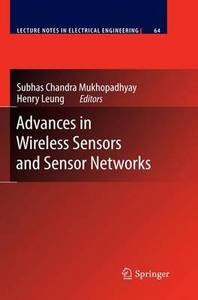Thermal energy harvesting for wireless sensor nodes with case studies
Knight, C., and Davidson, J. (2010) Thermal energy harvesting for wireless sensor nodes with case studies. In: Mukhopadhyay, Subhas Chandra , and Leung, Henry, (eds.) Advances in Wireless Sensors and Sensor Networks. Lecture Notes in Electrical Engineering, 64 . Springer, Berlin, pp. 221-242.
![[img]](https://researchonline.jcu.edu.au/15846/1.hassmallThumbnailVersion/15846_Davidson_%26_Knight_2010_Book_Cover.jpg)
|
Image (JPEG) (Book Cover)
- Cover Image
Download (11kB) |
|
|
PDF (Published Version)
- Published Version
Restricted to Repository staff only |
Abstract
Over the last decade, wireless computing and mobile devices have decreased in size and power requirements. These devices traditionally had significant power requirements that necessitated the use of batteries as their power source. However, as the power requirements are reducing, with wireless sensor nodes rarely exceeding 75mW, alternative means of power provision become available. One of these alternatives is the use of thermal energy harvesting from waste heat or environmental sources. This report discusses the field of thermal energy harvesting, with a particular focus on those thermal technologies that provide direct electricity as output. There are a number of technologies in this field. The general technologies discussed in this report are thermoelectric devices, such as devices utilising the Seebeck effect, thermocouples and, thermionics. Sources of thermal energy discussed include solar, the human body, vehicle exhaust systems and subsurface heating. Solar has an obvious advantage of being a very large source of energy. Cases studies are presented to show magnitudes and the daily variation of power output from Seebeck style thermoelectric devices. Overall, this report reveals that while present thermal energy harvesting technologies suffer from very low efficiencies, there are a number of promising technologies that are increasing in reliability and efficiency. This, along with a continuing decrease in power requirements on the demand side of the equation, marks thermal energy harvesting as a very promising field of research.
| Item ID: | 15846 |
|---|---|
| Item Type: | Book Chapter (Research - B1) |
| ISBN: | 978-3-642-12706-9 |
| Date Deposited: | 19 Apr 2011 05:50 |
| FoR Codes: | 02 PHYSICAL SCIENCES > 0299 Other Physical Sciences > 029999 Physical Sciences not elsewhere classified @ 100% |
| SEO Codes: | 85 ENERGY > 8505 Renewable Energy > 850599 Renewable Energy not elsewhere classified @ 100% |
| Downloads: |
Total: 925 Last 12 Months: 2 |
| More Statistics |




